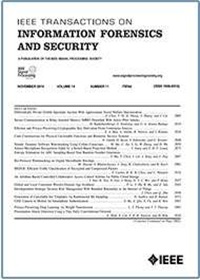内积掩蔽下非轮廓高阶区分符的统计分析
IF 6.3
1区 计算机科学
Q1 COMPUTER SCIENCE, THEORY & METHODS
IEEE Transactions on Information Forensics and Security
Pub Date : 2025-04-07
DOI:10.1109/TIFS.2025.3558601
引用次数: 0
摘要
内积掩蔽(IPM)是一种典型的掩蔽方案,它利用了所谓的安全顺序放大(SOA)特性。人们普遍认为,SOA在线性泄漏情况下仍然有效。在本文中,我们将从非分析攻击的角度重新审视SOA。具体来说,我们对Pearson系数区分器(PCD)、Spearman系数区分器(SCD)和Kruskal-Wallis系数区分器(KWD)三种非侧写区分器进行了统计分析。我们发现SCD和KWD之间有一个基本的联系,因此SCD是一个更通用的区别,包括KWD。本文从理论上解释了在非线性泄漏情况下KWD优于SCD的原因。我们还提出了一种新的调整后的SCD,并提出了其最佳形式,以弥补与KWD的效率差距。在此基础上,对SOA进行了广泛的评估,观察结果是双重的。一方面,通过PCD的统计分析,再次证实了汉明权重泄漏下SOA的有效性。另一方面,我们表明,即使在线性泄漏(据我们所知,以前从未发现过)的情况下,SOA也不能抵抗基于等级的区分。最后,我们通过模拟和实际测量验证了理论结果。我们的研究结果证明了基于等级的区分器在揭示隐藏在泄漏中的非线性关系方面的优势,丰富了非分析类侧信道攻击的工具集。值得注意的是,我们提供了一个对手的视角来研究SOA,强调SOA承诺的侧通道阻力是脆弱的,即使考虑到理想的线性泄漏模型。本文章由计算机程序翻译,如有差异,请以英文原文为准。
Statistical Analysis of Non-Profiling Higher-Order Distinguishers Against Inner Product Masking
Inner Product Masking (IPM) is one representative masking scheme, which captivates by so-called Security Order Amplification (SOA) property. It is commonly recognized that SOA holds under linear leakages. In this paper, we revisit SOA from a non-profiling attack perspective. Specifically, we conduct statistical analyses on three non-profiling distinguishers, including Pearson Coefficient Distinguisher (PCD), Spearman Coefficient Distinguisher (SCD) and Kruskal-Wallis Distinguisher (KWD). We find a fundamental connection between SCD and KWD such that SCD is a more generic distinguisher which encompasses KWD. Theoretical explanations for why KWD outperforms SCD under non-linear leakages are provided. We also propose a new adjusted SCD and present its optimal form, which bridges the efficiency gap with KWD. Grounded on this, SOA is extensively assessed and the observations are two-fold. On the one hand, we confirm again the effectiveness of SOA under Hamming weight leakage through the statistical analysis of PCD. On the other hand, we show that SOA can not resist rank-based distinguishers even under linear leakages, which has never been revealed before (to the best of our knowledge). At last, we verify the theoretical findings through both simulated and real-world measurements. Our results demonstrate the advantage of rank-based distinguishers in uncovering non-linear relationships hidden in leakage, enriching the tool-set for non-profiling class of side-channel attacks. Remarkably, we provide an adversary perspective to investigate SOA, highlighting that the side-channel resistance promised by SOA is vulnerable even considering the ideal linear leakage models.
求助全文
通过发布文献求助,成功后即可免费获取论文全文。
去求助
来源期刊

IEEE Transactions on Information Forensics and Security
工程技术-工程:电子与电气
CiteScore
14.40
自引率
7.40%
发文量
234
审稿时长
6.5 months
期刊介绍:
The IEEE Transactions on Information Forensics and Security covers the sciences, technologies, and applications relating to information forensics, information security, biometrics, surveillance and systems applications that incorporate these features
 求助内容:
求助内容: 应助结果提醒方式:
应助结果提醒方式:


